light FIAT 500 1962 1.G Owner's Manual
[x] Cancel search | Manufacturer: FIAT, Model Year: 1962, Model line: 500, Model: FIAT 500 1962 1.GPages: 128, PDF Size: 9.01 MB
Page 100 of 128
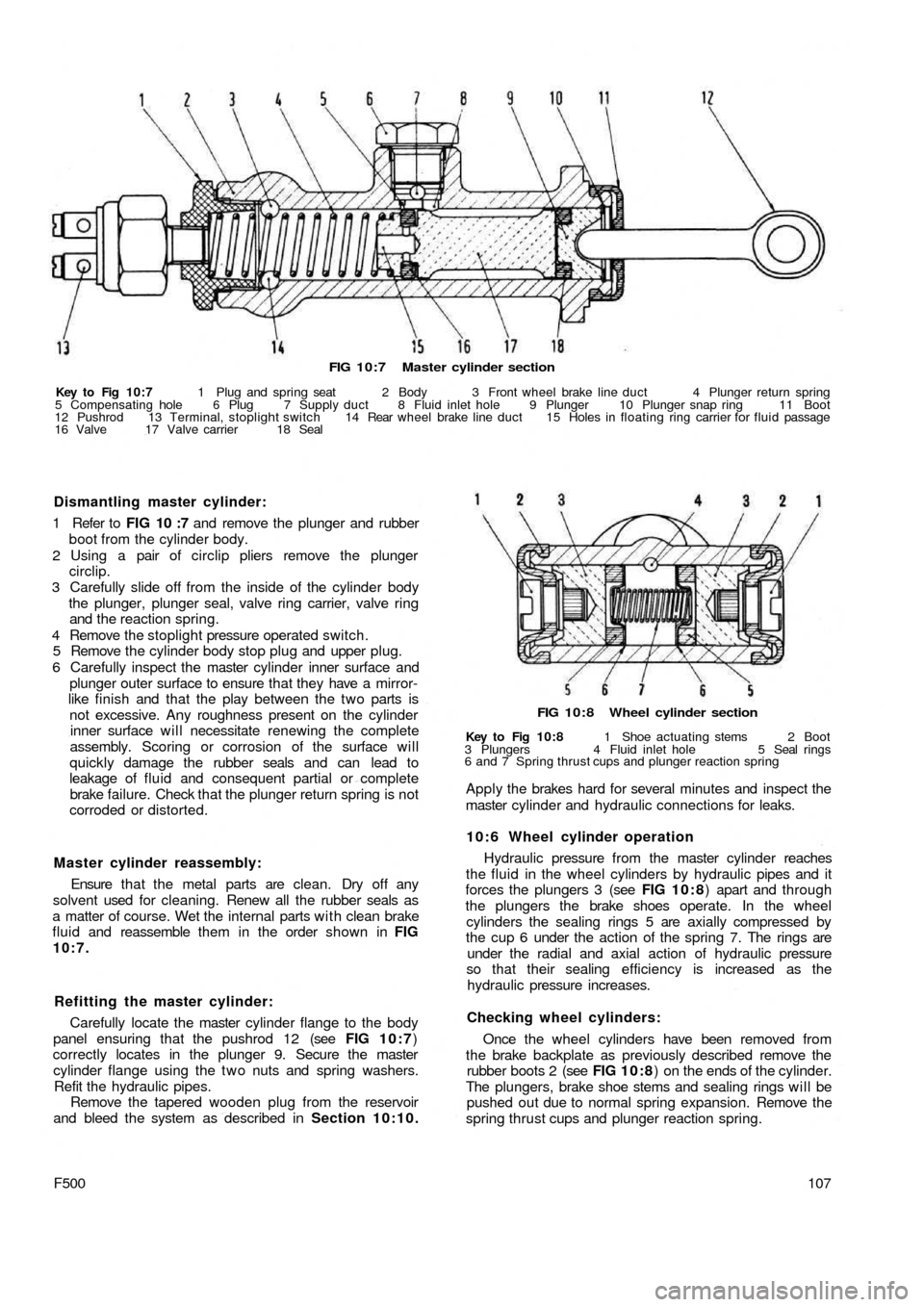
FIG 10:7 Master cylinder section
Key to Fig 10:7 1 Plug and spring seat 2 Body 3 Front wheel brake line duct 4 Plunger return spring
5 Compensating hole 6 Plug 7 Supply duct 8 Fluid inlet hole 9 Plunger 10 Plunger snap ring 11 Boot
12 Pushrod 13 Terminal, stoplight switch 14 Rear wheel brake line duct 15 Holes in floating ring carrier for fluid passage
16 Valve 17 Valve carrier 18 Seal
FIG 10:8 Wheel cylinder section
Key to Fig 10:8 1 Shoe actuating stems 2 Boot
3 Plungers 4 Fluid inlet hole 5 Seal rings
6 and 7 Spring thrust cups and plunger reaction spring
Apply the brakes hard for several minutes and inspect the
master cylinder and hydraulic connections for leaks.
10:6 Wheel cylinder operation
Hydraulic pressure from the master cylinder reaches
the fluid in the wheel cylinders by hydraulic pipes and it
forces the plungers 3 (see FIG 1 0 : 8) apart and through
the plungers the brake shoes operate. In the wheel
cylinders the sealing rings 5 are axially compressed by
the cup 6 under the action of the spring 7. The rings are
under the radial and axial action of hydraulic pressure
so that their sealing efficiency is increased as the
hydraulic pressure increases.
Checking wheel cylinders:
Once the wheel cylinders have been removed from
the brake backplate as previously described remove the
rubber boots 2 (see FIG 10:8) on the ends of the cylinder.
The plungers, brake shoe stems and sealing rings will be
pushed out due to normal spring expansion. Remove the
spring thrust cups and plunger reaction spring.
107F500
Master cylinder reassembly:
Ensure that the metal parts are clean. Dry off any
solvent used for cleaning. Renew all the rubber seals as
a matter of course. Wet the internal parts w i t h clean brake
fluid and reassemble them in the order shown in FIG
10:7.
Refitting the master cylinder:
Carefully locate the master cylinder flange to the body
panel ensuring that the pushrod 12 (see FIG 10:7)
correctly locates in the plunger 9. Secure the master
cylinder flange using the t w o nuts and spring washers.
Refit the hydraulic pipes.
Remove the tapered wooden plug from the reservoir
and bleed the system as described in Section 10:10. Dismantling master cylinder:
1 Refer to FIG 10 :7 and remove the plunger and rubber
boot from the cylinder body.
2 Using a pair of circlip pliers remove the plunger
circlip.
3 Carefully slide off from the inside of the cylinder body
the plunger, plunger seal, valve ring carrier, valve ring
and the reaction spring.
4 Remove the stoplight pressure operated switch.
5 Remove the cylinder body stop plug and upper plug.
6 Carefully inspect the master cylinder inner surface and
plunger outer surface to ensure that they have a mirror-
like finish and that the play between the two parts is
not excessive. Any roughness present on the cylinder
inner surface will necessitate renewing the complete
assembly. Scoring or corrosion of the surface will
quickly damage the rubber seals and can lead to
leakage of fluid and consequent partial or complete
brake failure. Check that the plunger return spring is not
corroded or distorted.
Page 101 of 128
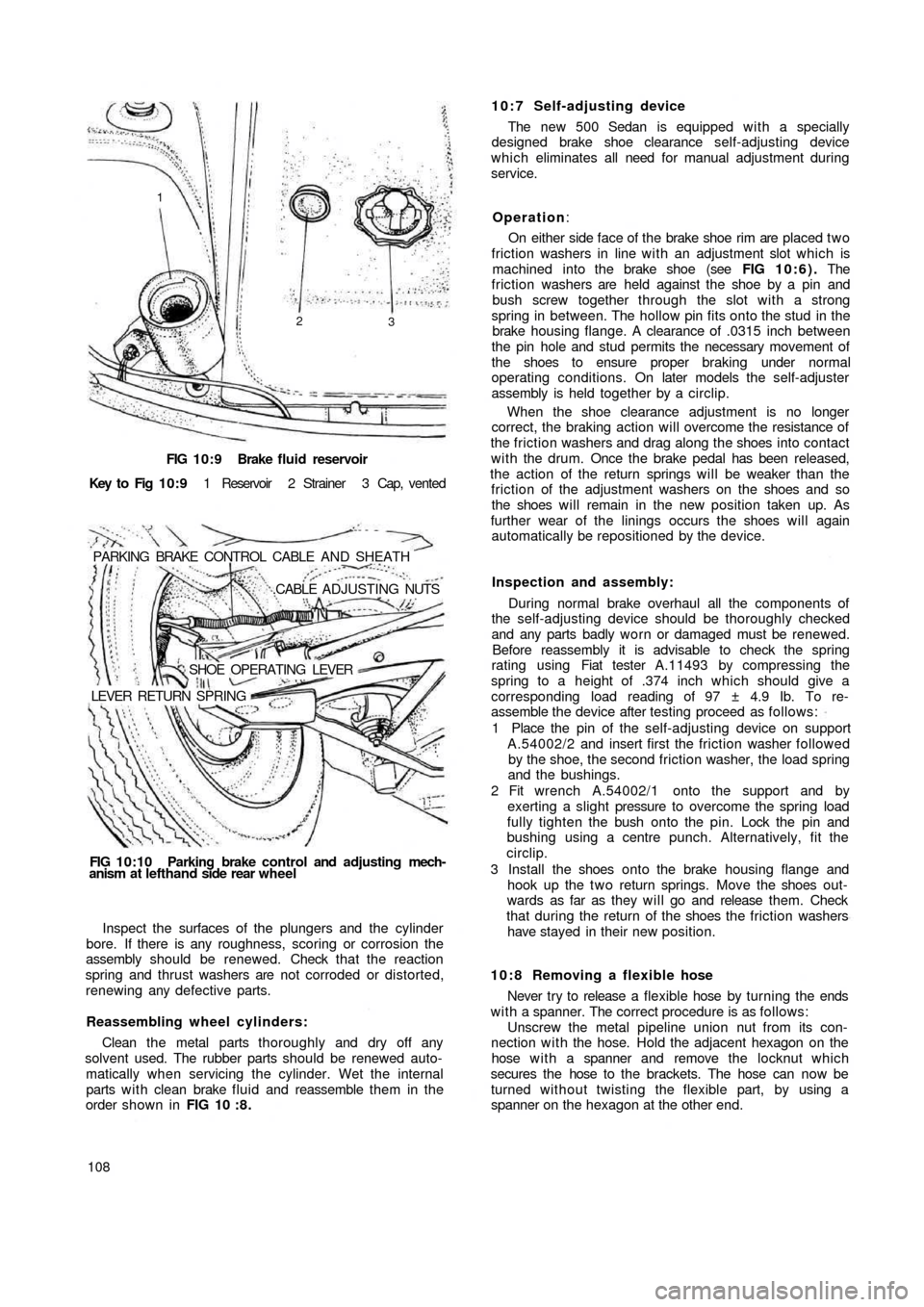
FIG 10:9 Brake fluid reservoir
Key to Fig 1 0 : 9 1 Reservoir 2 Strainer 3 Cap, vented
PARKING BRAKE CONTROL CABLE AND SHEATH
.CABLE ADJUSTING NUTS
SHOE OPERATING LEVER
LEVER RETURN SPRING
FIG 10:10 Parking brake control and adjusting mech-
anism at lefthand side rear wheel
Inspect the surfaces of the plungers and the cylinder
bore. If there is any roughness, scoring or corrosion the
assembly should be renewed. Check that the reaction
spring and thrust washers are not corroded or distorted,
renewing any defective parts.
Reassembling wheel cylinders:
Clean the metal parts thoroughly and dry off any
solvent used. The rubber parts should be renewed auto-
matically when servicing the cylinder. Wet the internal
parts w i t h clean brake f l u i d and reassemble them in the
order shown in FIG 10 : 8 .
10810:7 Self-adjusting device
The new 500 Sedan is equipped with a specially
designed brake shoe clearance self-adjusting device
which eliminates all need for manual adjustment during
service.
Operation:
On either side face of the brake shoe rim are placed t w o
friction washers in line with an adjustment slot which is
machined into the brake shoe (see FIG 10:6). The
friction washers are held against the shoe by a pin and
bush screw together through the slot with a strong
spring in between. The hollow pin fits onto the stud in the
brake housing flange. A clearance of .0315 inch between
the pin hole and stud permits the necessary movement of
the shoes to ensure proper braking under normal
operating conditions. On later models the self-adjuster
assembly is held together by a circlip.
When the shoe clearance adjustment is no longer
correct, the braking action will overcome the resistance of
the friction washers and drag along the shoes into contact
with the drum. Once the brake pedal has been released,
the action of the return springs will be weaker than the
friction of the adjustment washers on the shoes and so
the shoes will remain in the new position taken up. As
further wear of the linings occurs the shoes will again
automatically be repositioned by the device.
Inspection and assembly:
During normal brake overhaul all the components of
the self-adjusting device should be thoroughly checked
and any parts badly worn or damaged must be renewed.
Before reassembly it is advisable to check the spring
rating using Fiat tester A.11493 by
compressing the
spring to a height of .374 inch which should give a
corresponding load reading of 97 ± 4.9 Ib. To re-
assemble the device after testing proceed as follows:
1 Place the pin of the self-adjusting device on support
A.54002/2 and insert first the friction washer followed
by the shoe, the second friction washer, the load spring
and the bushings.
2 Fit wrench A.54002/1 onto the support and by
exerting a slight pressure to overcome the spring load
fully tighten the bush onto the pin. Lock the pin and
bushing using a centre punch. Alternatively, fit the
circlip.
3 Install the shoes onto the brake housing flange and
hook up the t w o return springs. Move the shoes out-
wards as far as they will go and release them. Check
that during the return of the shoes the friction washers
have stayed in their new position.
10:8 Removing a flexible hose
Never try to release a flexible hose by turning the ends
w i t h a spanner. The correct procedure is as follows:
Unscrew the metal pipeline union nut from its con-
nection with the hose. Hold the adjacent hexagon on the
hose w i t h a spanner and remove the locknut which
secures the hose to the brackets. The hose can now be
turned without twisting the flexible part, by using a
spanner on the hexagon at the other end.
1
2
3
Page 104 of 128
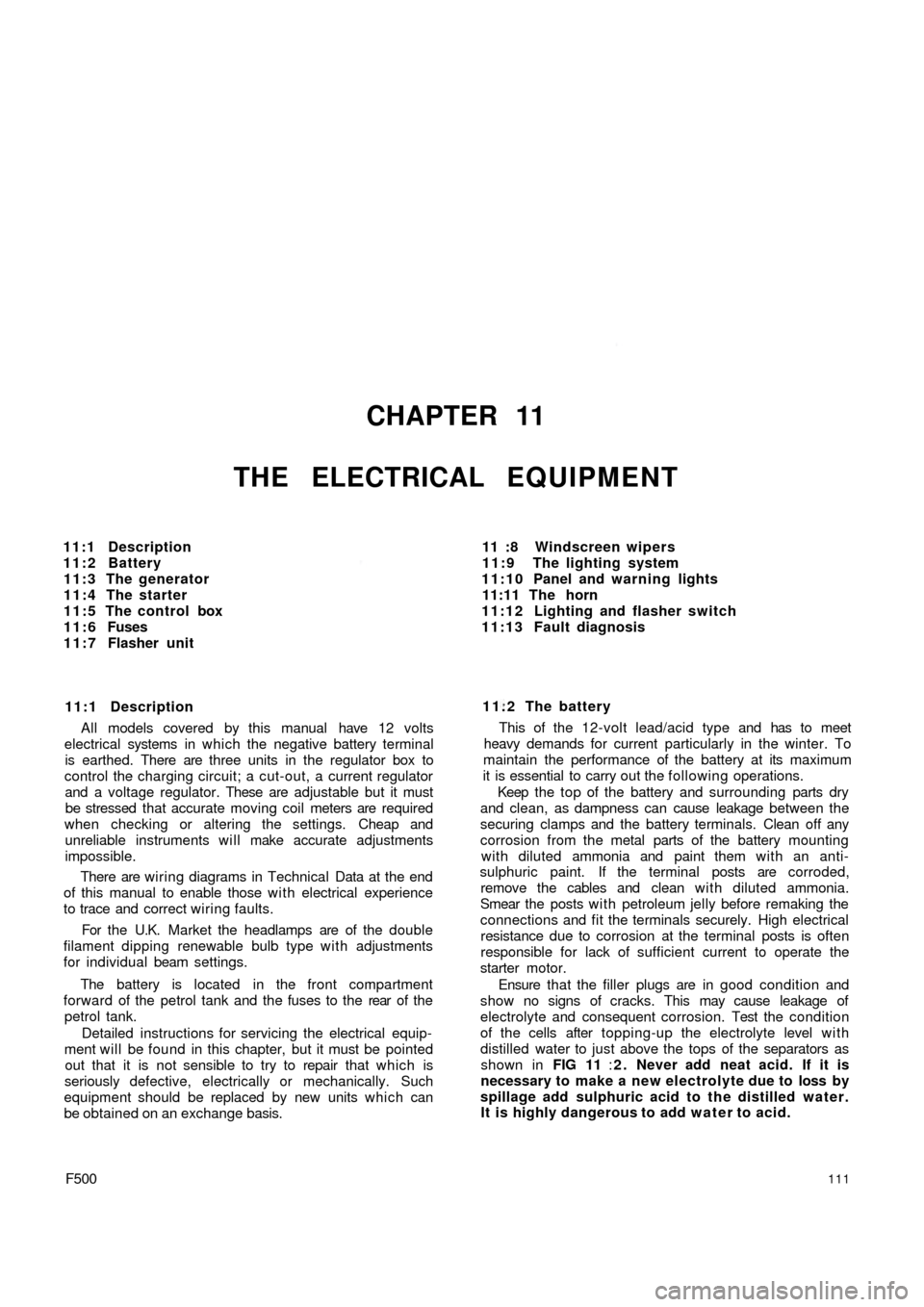
CHAPTER 11
THE ELECTRICAL EQUIPMENT
11:1 Description
11:2 Battery
11:3 The generator
11:4 The starter
11:5 The control box
1 1 : 6 Fuses
1 1 : 7 Flasher unit
11:1 Description
All models covered by this manual have 12 volts
electrical systems in which the negative battery terminal
is earthed. There are three units in the regulator box to
control the charging circuit; a cut-out, a current regulator
and a voltage regulator. These are adjustable but it must
be stressed that accurate moving coil meters are required
when checking or altering the settings. Cheap and
unreliable instruments will make accurate adjustments
impossible.
There are wiring diagrams in Technical Data at the end
of this manual to enable those with electrical experience
to trace and correct wiring faults.
For t h e U.K. Market the headlamps are of the double
filament dipping renewable bulb type with adjustments
for individual beam settings.
The battery is located in the front compartment
forward of the petrol tank and the fuses to the rear o f the
petrol tank.
Detailed instructions for servicing the electrical equip-
ment will be found in this chapter, but it must be pointed
out that it is not sensible to try to repair that which is
seriously defective, electrically or mechanically. Such
equipment should be replaced by new units which can
be obtained on an exchange basis.
F500111
11 :8 Windscreen wipers
1 1 : 9 The lighting system
11:10 Panel and warning lights
11:11 The horn
11:12 Lighting and flasher switch
1 1 : 1 3 Fault diagnosis
11.2 The battery
This of the 12-volt lead/acid type and has to meet
heavy demands for current particularly in the winter. To
maintain the performance of the battery at its maximum
it is essential to carry out the following operations.
Keep the top of the battery and surrounding parts dry
and clean, as dampness can cause leakage between the
securing clamps and the battery terminals. Clean off any
corrosion from the metal parts of the battery mounting
with diluted ammonia and paint them with an anti-
sulphuric paint. If the terminal posts are corroded,
remove the cables and clean w i t h diluted ammonia.
Smear the posts w i t h petroleum jelly before remaking the
connections and fit the terminals securely. High electrical
resistance due to corrosion at the terminal posts is often
responsible for lack of sufficient current to operate the
starter motor.
Ensure t h a t the filler plugs are in good condition and
show no signs of cracks. This may cause leakage of
electrolyte and consequent corrosion. Test the condition
of the cells after topping-up the electrolyte level with
distilled water to just above the tops of the separators as
shown in FIG 11 :2 . Never add neat acid. If it is
necessary to make a new electrolyte due to loss by
spillage add sulphuric acid to the
distilled water.
It is highly dangerous to add water to acid.
Page 105 of 128
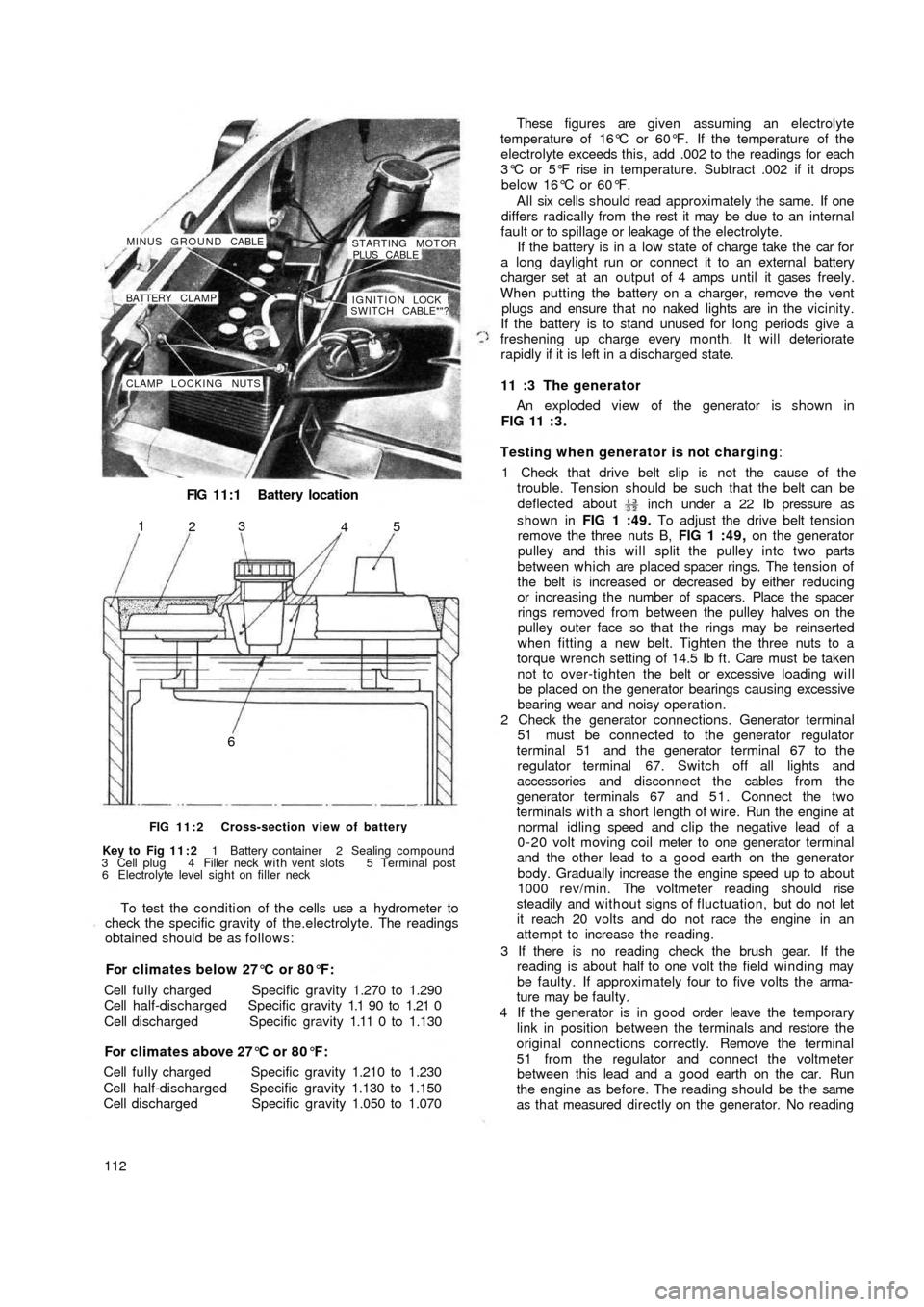
FIG 11:1 Battery location
CLAMP LOCKING NUTSIGNITION LOCK !
SWITCH CABLE*"? BATTERY CLAMP MINUS GROUND CABLE
STARTING MOTOR
PLUS CABLE
65
4 3
2 1
FIG 11:2 Cross-section view of battery
Key to Fig 11:2 1 Battery container 2 Sealing compound
3 Cell plug 4 Filler neck with vent slots 5 Terminal post
6 Electrolyte level sight on filler neck
To test the condition of the cells use a hydrometer to
check the specific gravity of the.electrolyte. The readings
obtained should be as follows:
For climates below 27°C or 80°F:
Cell fully charged Specific gravity 1.270 to 1.290
Cell half-discharged Specific gravity 1.1 90 to 1.21 0
Cell discharged Specific gravity 1.11 0 to 1.130
For climates above 27°C or 80°F:
Cell fully charged Specific gravity 1.210 to 1.230
Cell half-discharged Specific gravity 1.130 to 1.150
Cell discharged Specific gravity 1.050 to 1.070
112These figures are given assuming an electrolyte
temperature of 16°C or 60°F. If the temperature of the
electrolyte exceeds this, add .002 to the readings for each
3°C or 5°F rise in temperature. Subtract .002 if it drops
below 16°C or 60°F.
All six cells should read approximately the same. If one
differs radically from the rest it may be due to an internal
fault or to spillage or leakage of the electrolyte.
If the battery is in a low state of charge take the car for
a long daylight run or connect it to an external battery
charger set at an output of 4 amps until it gases freely.
When putting the battery on a charger, remove the vent
plugs and ensure that no naked lights are in the vicinity.
If the battery is to stand unused for long periods give a
freshening up charge every month. It will deteriorate
rapidly if it is left in a discharged state.
11 :3 The generator
An exploded view of the generator is shown in
FIG 11 : 3 .
Testing when generator is not charging:
1 Check that drive belt slip is not the cause of the
trouble. Tension should be such that the belt can be
deflected about
inch under a 22 Ib pressure as
shown in FIG 1 :49. To adjust the drive belt tension
remove the three nuts B, FIG 1 :49, on the generator
pulley and this will split the pulley into two parts
between which are placed spacer rings. The tension of
the belt is increased or decreased by either reducing
or increasing the number of spacers. Place the spacer
rings removed from between the pulley halves on the
pulley outer face so that the rings may be reinserted
when fitting a new belt. Tighten the three nuts to a
torque wrench setting of 14.5 Ib ft. Care must be taken
not to over-tighten the belt or excessive loading will
be placed on the generator bearings causing excessive
bearing wear and noisy operation.
2 Check the generator connections. Generator terminal
51 must be connected to the generator regulator
terminal 51 and the generator terminal 67 to the
regulator terminal 67. Switch off all lights and
accessories and disconnect the cables from the
generator terminals 67 and 5 1 . Connect the two
terminals with a short length of wire. Run the engine at
normal idling speed and clip the negative lead of a
0-20 volt moving coil meter to one generator terminal
and the other lead to a good earth on the generator
body. Gradually increase the
engine speed up to about
1000 rev/min. The voltmeter reading should rise
steadily and without signs of fluctuation, but do not let
it reach 20 volts and do not race the engine in an
attempt to increase the reading.
3 If there is no reading check the brush gear. If the
reading is about half to one volt the field winding may
be faulty. If approximately four to five volts the arma-
ture may be faulty.
4 If the generator is in good order leave the temporary
link in position between the terminals and restore the
original connections correctly. Remove the terminal
51 from the regulator and connect the voltmeter
between this lead and a good earth on the car. Run
the engine as before. The reading should be the same
as that measured directly on the generator. No reading
Page 106 of 128
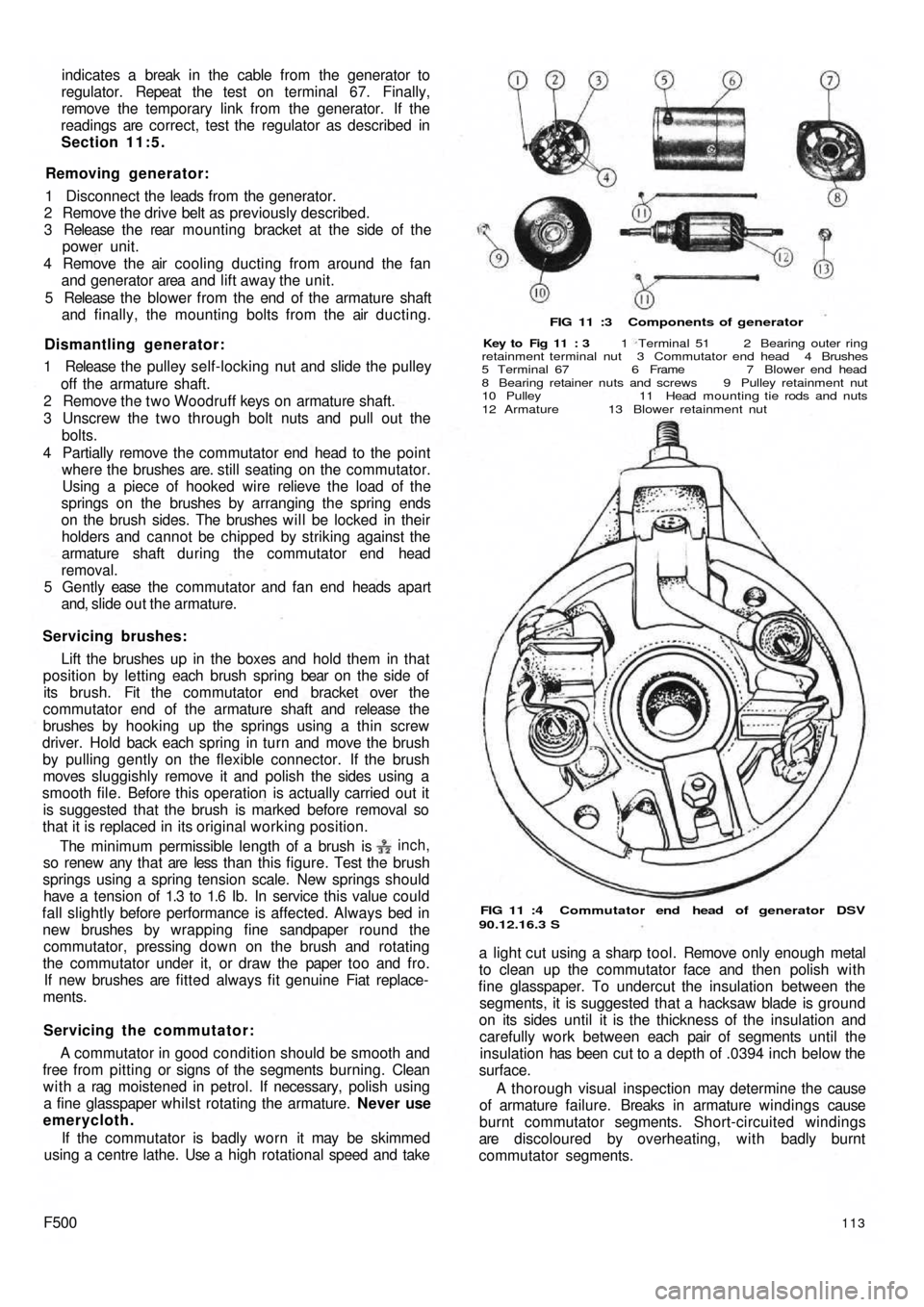
indicates a break in the cable from the generator to
regulator. Repeat the test on terminal 67. Finally,
remove the temporary link from the generator. If the
readings are correct, test the regulator as described in
Section 11:5.
Removing generator:
1 Disconnect the leads from the generator.
2 Remove the drive belt as previously described.
3 Release t h e rear mounting bracket at the side of the
power unit.
4 Remove the air cooling ducting from around the fan
and generator area and lift away the unit.
5 Release the blower from the end of the armature shaft
and finally, the mounting bolts from the air ducting.
Dismantling generator:
1 Release the pulley self-locking nut and slide the pulley
off the armature shaft.
2 Remove the t w o Woodruff keys on armature shaft.
3 Unscrew the t w o through bolt nuts and pull out the
bolts.
4 Partially remove the commutator end head to the point
where the brushes are. s t i l l seating on the commutator.
Using a piece of hooked wire relieve the load of the
springs on the brushes by arranging the spring ends
on the brush sides. The brushes will be locked in their
holders and cannot be chipped by striking against the
armature shaft during the commutator end head
removal.
5 Gently ease the commutator and fan end heads apart
and, slide out the armature.
Servicing brushes:
Lift the brushes up in the boxes and hold them in that
position by letting each brush spring bear on the side of
its brush. Fit the commutator end bracket over the
commutator end of the armature shaft and release the
brushes by hooking up the springs using a thin screw
driver. Hold back each spring in turn and move the brush
by pulling gently on the flexible connector. If the brush
moves sluggishly remove it and polish the sides using a
smooth file. Before this operation is actually carried out it
is suggested that the brush is marked before removal so
that it is replaced in its original working position.
inch,The minimum permissible length of a brush is
so renew any t h a t are less than this figure. Test the brush
springs using a spring tension scale. New springs should
have a tension of 1.3 to 1.6 Ib. In service this value could
fall slightly before performance is affected. Always bed in
new brushes by wrapping fine sandpaper round the
commutator, pressing down on the brush and rotating
the commutator under it, or draw the paper t o o and f r o .
If new brushes are fitted always fit genuine Fiat replace-
ments.
Servicing the commutator:
A commutator in good condition should be smooth and
free from pitting or signs of the segments burning. Clean
with a rag moistened in petrol. If necessary, polish using
a fine glasspaper whilst rotating the armature. Never use
emerycloth.
If the commutator is badly worn it may be skimmed
using a centre lathe. Use a high rotational speed and take
F500113
FIG 11 :3 Components of generator
Key to Fig 11 : 3 1 Terminal 51 2 Bearing outer ring
retainment terminal nut 3 Commutator end head 4 Brushes
5 Terminal 67 6 Frame 7 Blower end head
8 Bearing retainer nuts and screws 9 Pulley retainment nut
10 Pulley 11 Head mounting tie rods and nuts
12 Armature 13 Blower retainment nut
FIG 11 :4 Commutator end head of generator DSV
90.12.16.3 S
a light cut using a sharp tool. Remove only enough metal
to clean up the commutator face and then polish with
fine glasspaper. To undercut the insulation between the
segments, it is suggested that a hacksaw blade is ground
on its sides until it is the thickness of the insulation and
carefully work between each pair of segments until the
insulation has been cut to a depth of .0394 inch below the
surface.
A thorough visual inspection may determine the cause
of armature failure. Breaks in armature windings cause
burnt commutator segments. Short-circuited windings
are discoloured by overheating, with badly burnt
commutator segments.
Page 108 of 128
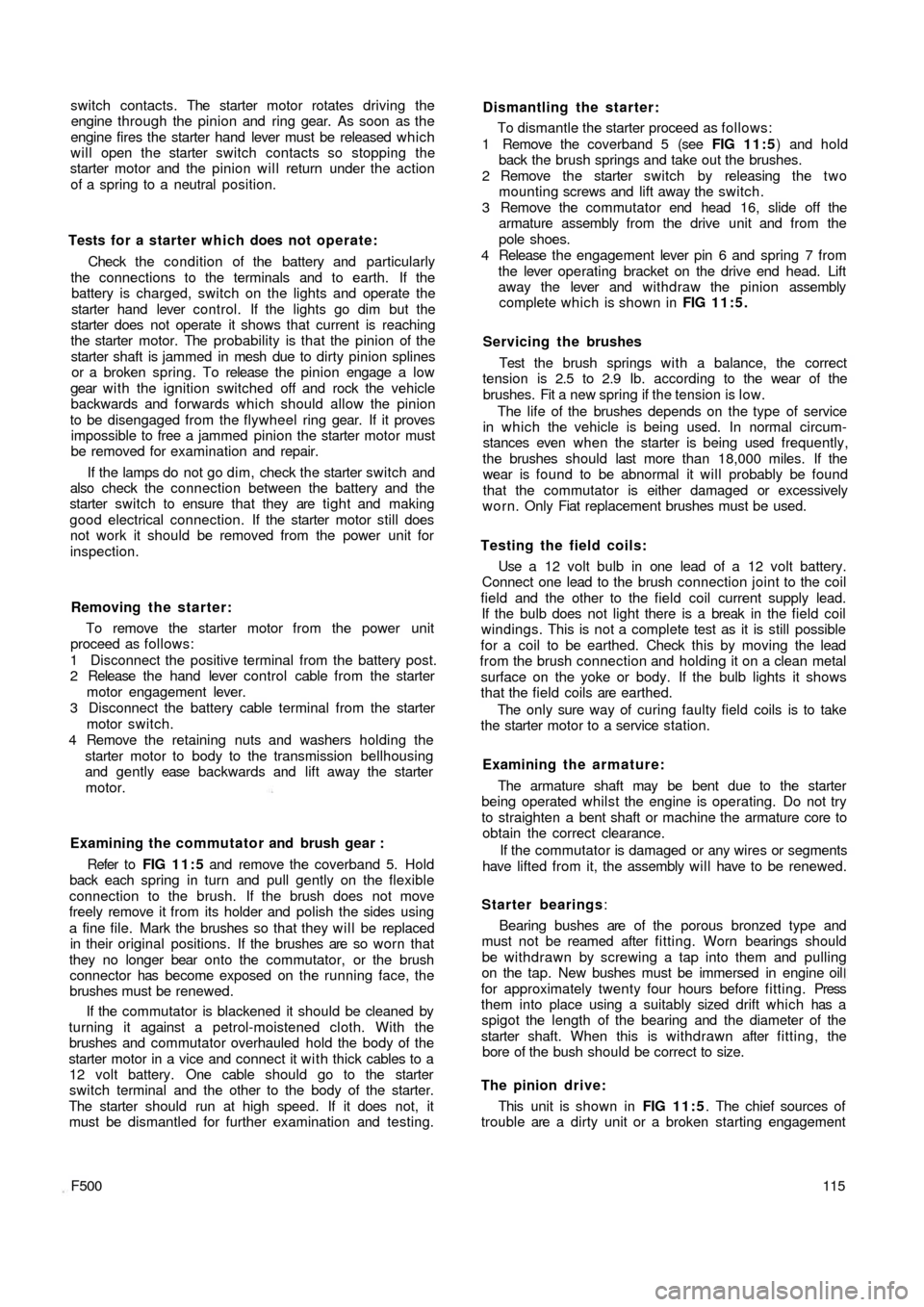
switch contacts. The starter motor rotates driving the
engine through the pinion and ring gear. As soon as the
engine fires the starter hand lever must be released which
will open the starter switch contacts so stopping the
starter motor and the pinion will return under the action
of a spring to a neutral position.
Tests for a starter which does not operate:
Check the condition of the battery and particularly
the connections to the terminals and to earth. If the
battery is charged, switch on the lights and operate the
starter hand lever control. If the lights go dim but the
starter does not operate it shows that current is reaching
the starter motor. The probability is that the pinion of the
starter shaft is jammed in mesh due to dirty pinion splines
or a broken spring. To release the pinion engage a low
gear with the ignition switched off and rock the vehicle
backwards and forwards which should allow the pinion
to be disengaged from the flywheel ring gear. If it proves
impossible to free a jammed pinion the starter motor must
be removed for examination and repair.
If the lamps do not go dim, check the starter switch and
also check the connection between the battery and the
starter switch to ensure that they are tight and making
good electrical connection. If the starter motor still does
not work it should be removed from the power unit for
inspection.
Removing the starter:
To remove the starter motor from the power unit
proceed as follows:
1 Disconnect the positive terminal from the
battery post.
2 Release the hand lever control cable from the starter
motor engagement lever.
3 Disconnect the battery cable terminal from the starter
motor switch.
4 Remove the retaining nuts and washers holding the
starter motor to body to the transmission bellhousing
and gently ease backwards and lift away the starter
motor.
Examining the commutator and brush gear :
Refer to FIG 11:5 and remove the coverband 5. Hold
back each spring in turn and pull gently on the flexible
connection to the brush. If the brush does not move
freely remove it from its holder and polish the sides using
a fine file. Mark the brushes so that they will be replaced
in their original positions. If the brushes are so worn that
they no longer bear onto the commutator, or the brush
connector has become exposed on the running face, the
brushes must be renewed.
If the commutator is blackened it should be cleaned by
turning it against a petrol-moistened cloth. With the
brushes and commutator overhauled hold the body of the
starter motor in a vice and connect it with thick cables to a
12 volt battery. One cable should go to the starter
switch terminal and the other to the body of the starter.
The starter should run at high speed. If it does not, it
must be dismantled for further examination and testing.
F500115 Dismantling the starter:
To dismantle the starter proceed as follows:
1 Remove the coverband 5 (see FIG 11:5) and hold
back the brush springs and take out the brushes.
2 Remove the starter switch by releasing the t w o
mounting screws and lift away the switch.
3 Remove the commutator end head 16, slide off the
armature assembly from the drive unit and from the
pole shoes.
4 Release the engagement lever pin 6 and spring 7 from
the lever operating bracket on the drive end head. Lift
away the lever and withdraw the pinion assembly
complete which is shown in FIG 11:5.
Servicing the brushes
Test the brush springs with a balance, the correct
tension is 2.5 to 2.9 Ib. according to the wear of the
brushes. Fit a new spring if the tension is low.
The life of the brushes depends on the type of service
in which the vehicle is being used. In normal circum-
stances even when the starter is being used frequently,
the brushes should last more than 18,000 miles. If the
wear is found to be abnormal it will probably be found
that the commutator is either damaged or excessively
w o r n . Only Fiat replacement brushes must be used.
Testing the field coils:
Use a 12 volt bulb in one lead of a 12 volt battery.
Connect one lead to the brush connection joint to the coil
field and the other to the field coil current supply lead.
If the bulb does not light there is a break in the f i e l d coil
windings. This is not a complete test as it is still possible
for a coil to be earthed. Check this by moving the lead
from the brush connection and holding it on a clean
metal
surface on the yoke or body. If the bulb lights it shows
that the field coils are earthed.
The only sure way of curing faulty field coils is to take
the starter motor to a service station.
Examining the armature:
The armature shaft may be bent due to the starter
being operated whilst the engine is operating. Do not try
to straighten a bent shaft or machine the armature core to
obtain the correct clearance.
If the commutator is damaged or any wires or segments
have lifted from it, the assembly will have to be renewed.
Starter bearings:
Bearing bushes are of the porous bronzed type and
must not be reamed after fitting. Worn bearings should
be withdrawn by screwing a tap into them and pulling
on the tap. New bushes must be immersed in engine oil
for approximately twenty four hours before fitting. Press
them into place using a suitably sized drift which has a
spigot the length of the bearing and the diameter of the
starter shaft. When this is withdrawn after fitting, the
bore of the bush should be correct to size.
The pinion drive:
This unit is shown in FIG 11:5. The chief sources of
trouble are a dirty unit or a broken starting engagement
Page 112 of 128
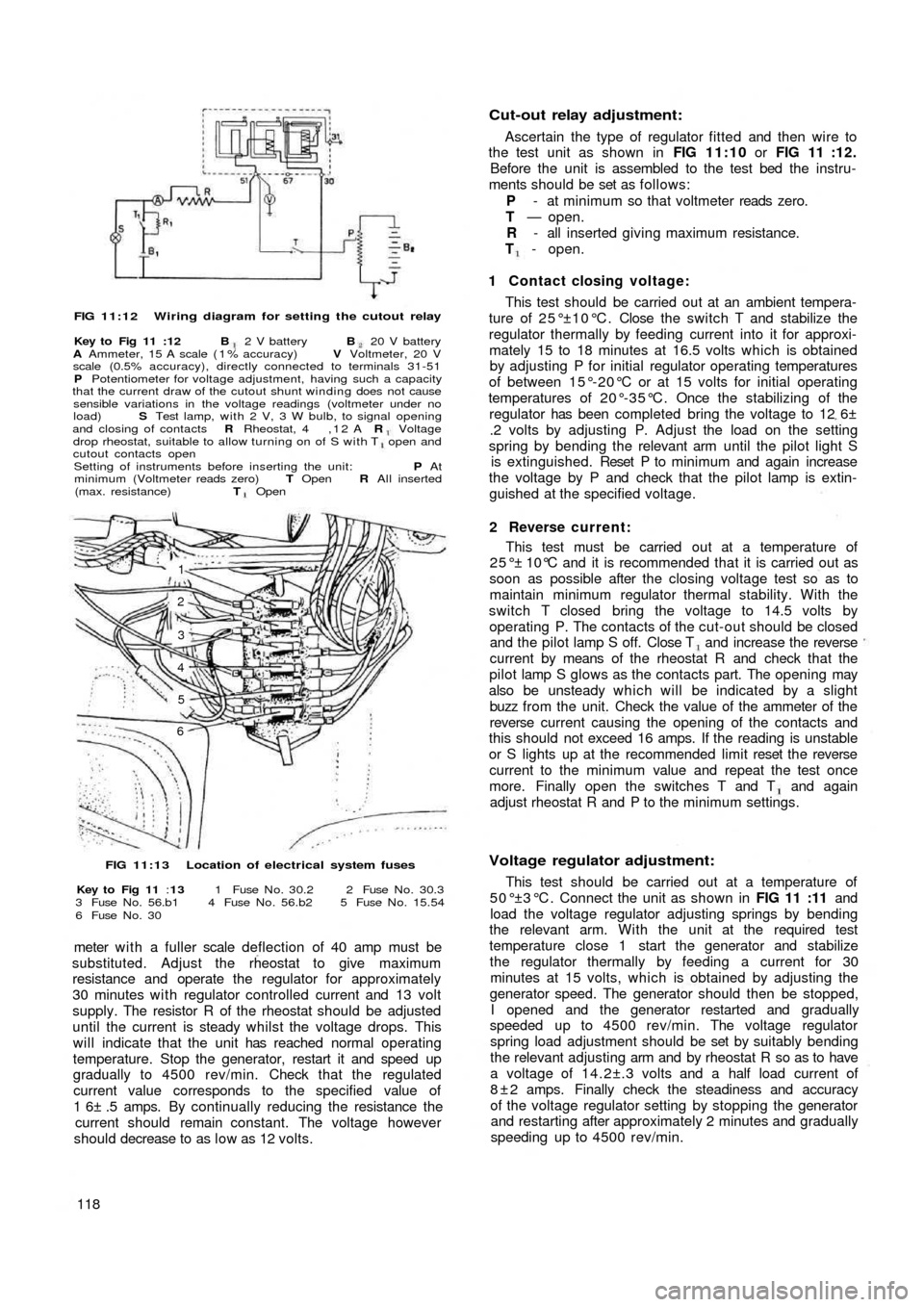
FIG 11:12 Wiring diagram for setting the cutout relay
Key to Fig 11 :12 B 2 V battery B 20 V battery
A Ammeter, 15 A scale ( 1 % accuracy) V Voltmeter, 20 V
scale (0.5% accuracy), directly connected to terminals 31-51
P Potentiometer for voltage adjustment, having such a capacity
that the current draw of the cutout shunt winding does not cause
sensible variations in the voltage readings (voltmeter under no
load) S Test lamp, with 2 V, 3 W bulb, to signal opening
and closing of contacts R Rheostat, 4 , 1 2 A R Voltagedrop rheostat, suitable to allow turning on of S with T open and
cutout contacts open
Setting of instruments before inserting the unit: P At
minimum (Voltmeter reads zero) T Open R All inserted
(max. resistance) T Open
1
2
3
4
5
6
FIG 11:13 Location of electrical system fuses
Key to Fig 11 :13 1 Fuse N o . 30.2 2 Fuse N o . 30.3
3 Fuse N o . 56.b1 4 Fuse N o . 56.b2 5 Fuse N o . 15.54
6 Fuse N o . 30
meter w i t h a fuller scale deflection of 40 amp must be
substituted. Adjust the rheostat to give maximum
resistance and operate the regulator for approximately
30 minutes with regulator controlled current and 13 volt
supply. The resistor R of the rheostat should be adjusted
until the current is steady whilst the voltage drops. This
will indicate that the unit has reached normal operating
temperature. Stop the generator, restart it and speed up
gradually to 4500 rev/min. Check that the regulated
current value corresponds to the specified value of
1 6± .5 amps. By continually reducing the resistance the
current should remain constant. The voltage however
should decrease to as l o w as 12 volts.
118
Cut-out relay adjustment:
Ascertain the type of regulator fitted and then wire to
the test unit as shown in FIG 11:10 or FIG 11 :12.
Before the unit is assembled to the test bed the instru-
ments should be set as follows:
P - at minimum so that voltmeter reads zero.
T — open.
R - all inserted giving maximum resistance.
T - open.
1 Contact closing voltage:
This test should be carried out at an ambient tempera-
ture of 25°±10°C. Close the switch T and stabilize the
regulator thermally by feeding current into it for approxi-
mately 15 to 18 minutes at 16.5 volts which is obtained
by adjusting P for initial regulator operating temperatures
of between 15°-20°C or at 15 volts for initial operating
temperatures of 20°-35°C. Once the stabilizing of the
regulator has been completed bring the voltage to 12 6±
.2 volts by adjusting P. Adjust the load on the setting
spring by bending the relevant arm until the pilot light S
is extinguished. Reset P to m inimum and again increase
the voltage by P and check that the pilot lamp is extin-
guished at the specified voltage.
2 Reverse current:
This test must be carried out at a temperature of
25°± 10°C and it is recommended that it is carried out as
soon as possible after the closing voltage test so as to
maintain minimum regulator thermal stability. With the
switch T closed bring the voltage to 14.5 volts by
operating P. The contacts of the cut-out should be closed
and the pilot lamp S off. Close T and increase the reverse
current by means of the rheostat R and check that the
pilot lamp S glows as the contacts part. The opening may
also be unsteady which will be indicated by a slight
buzz from the unit. Check the value of the ammeter of the
reverse current causing the opening of the contacts and
this should not exceed 16 amps. If the reading is unstable
or S lights up at the recommended limit reset the reverse
current to the minimum value and repeat the test once
more. Finally open the switches T and T and again
adjust rheostat R and P to the minimum settings.
Voltage regulator adjustment:
This test should be carried out at a temperature of
5 0 ° ±3 ° C . Connect the unit as shown in FIG 11 :11 and
load the voltage regulator adjusting springs by bending
the relevant arm. With the unit at the required test
temperature close 1 start the generator and stabilize
the regulator thermally by feeding a current for 30
minutes at 15 volts, which is obtained by adjusting the
generator speed. The generator should then be stopped,
I opened and the generator restarted and gradually
speeded up to 4500 rev/min. The voltage regulator
spring load adjustment should be set by suitably bending
the relevant adjusting arm and by rheostat R so as to have
a voltage of 14.2±.3 volts and a half load current of
8 ± 2 amps. Finally check the steadiness and accuracy
of the voltage regulator setting by stopping the generator
and restarting after approximately 2 minutes and gradually
speeding up to 4500 rev/min.
Page 113 of 128
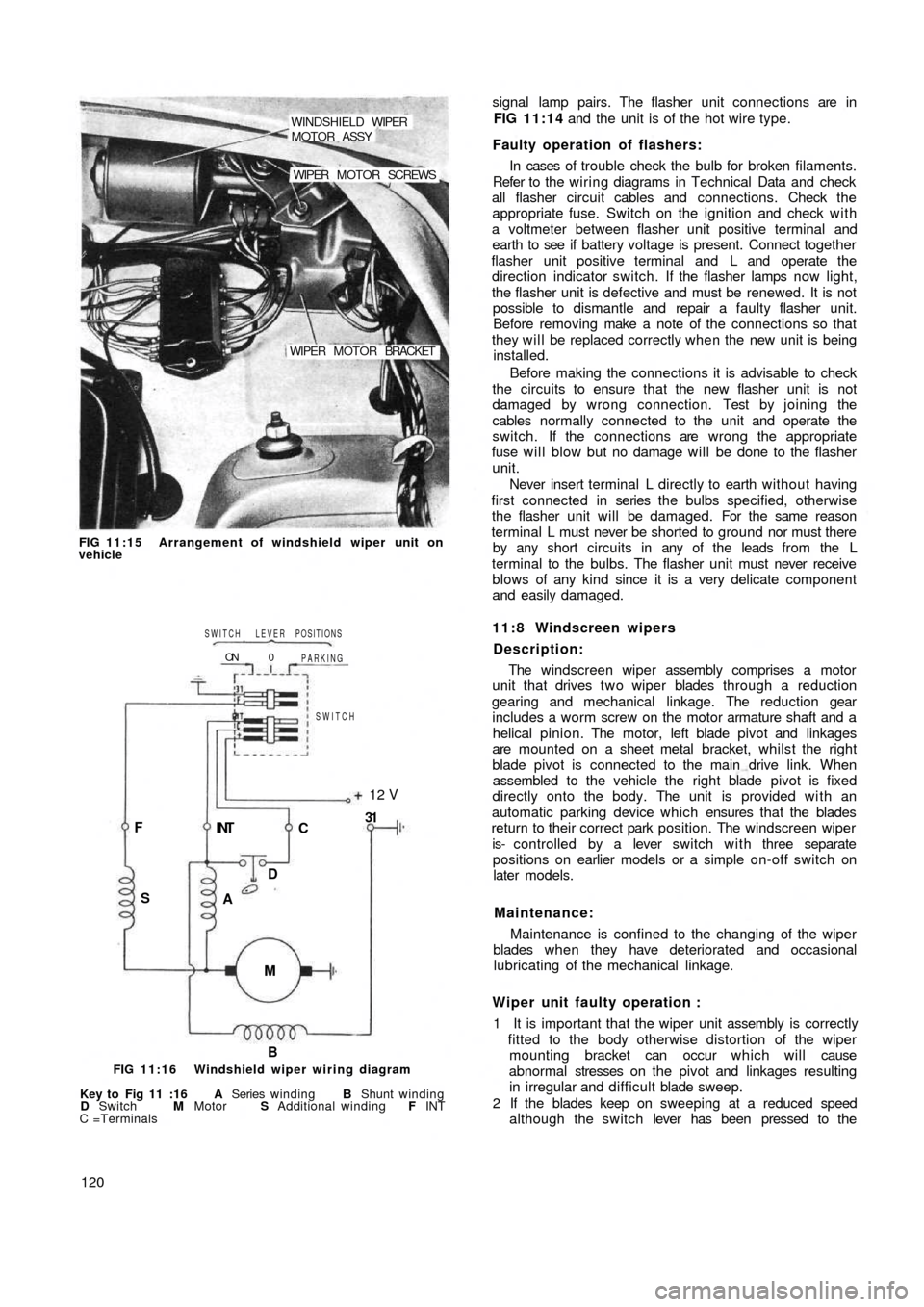
WINDSHIELD WIPER
MOTOR ASSY
WIPER MOTOR SCREWS
WIPER MOTOR BRACKET
FIG 11:15 Arrangement of windshield wiper unit on
vehicle
B M INT F
SC12 V
31
D
A
SWITCH PARKING
0 ON
SWITCH LEVER POSITIONS
FIG 11:16 Windshield wiper wiring diagram
Key to Fig 11 :16 A Series winding B Shunt winding
D Switch M Motor S Additional winding F INT
C =Terminals
120signal lamp pairs. The flasher unit connections are in
FIG 11:14 and the unit is of the hot wire type.
Faulty operation of flashers:
In cases of trouble check the bulb for broken filaments.
Refer to the wiring diagrams in Technical Data and check
all flasher circuit cables and connections. Check the
appropriate fuse. Switch on the ignition and check w i t h
a voltmeter between flasher unit positive terminal and
earth to see if battery voltage is present. Connect together
flasher unit positive terminal and L and operate the
direction indicator switch. If the flasher lamps now light,
the flasher unit is defective and must be renewed. It is not
possible to dismantle and repair a faulty flasher unit.
Before removing make a note of the connections so that
they will be replaced correctly when the new unit is being
installed.
Before making the connections it is advisable to check
the circuits to ensure that the new flasher unit is not
damaged by wrong connection. Test by joining the
cables normally connected to the unit and operate the
switch. If the connections are wrong the appropriate
fuse will blow but no damage will be done to the flasher
unit.
Never insert terminal L directly to earth without having
first connected in series the bulbs specified, otherwise
the flasher unit will be damaged. For the same reason
terminal L must never be shorted to ground nor must there
by any short circuits in any of the leads from the L
terminal to the bulbs. The flasher unit must never receive
blows of any kind since it is a very delicate component
and easily damaged.
11:8 Windscreen wipers
Description:
The windscreen wiper assembly comprises a motor
unit that drives t w o wiper blades through a reduction
gearing and mechanical linkage. The reduction gear
includes a worm screw on the motor armature shaft and a
helical pinion. The motor, left blade pivot and linkages
are mounted on a sheet metal bracket, whilst the right
blade pivot is connected to the main drive link. When
assembled to the vehicle the right blade pivot is fixed
directly onto the body. The unit is provided w i t h an
automatic parking device which ensures that the blades
return to their correct park position. The w
indscreen wiper
is- controlled by a lever switch with three separate
positions on earlier models or a simple on-off switch on
later models.
Maintenance:
Maintenance is confined to the changing of the wiper
blades when they have deteriorated and occasional
lubricating of the mechanical linkage.
Wiper unit faulty operation :
1 It is important that the wiper unit assembly is correctly
fitted to the body otherwise distortion of the wiper
mounting bracket can occur which will cause
abnormal stresses on the pivot and linkages resulting
in irregular and difficult blade sweep.
2 If the blades keep on sweeping at a reduced speed
although the switch lever has been pressed to the
Page 114 of 128
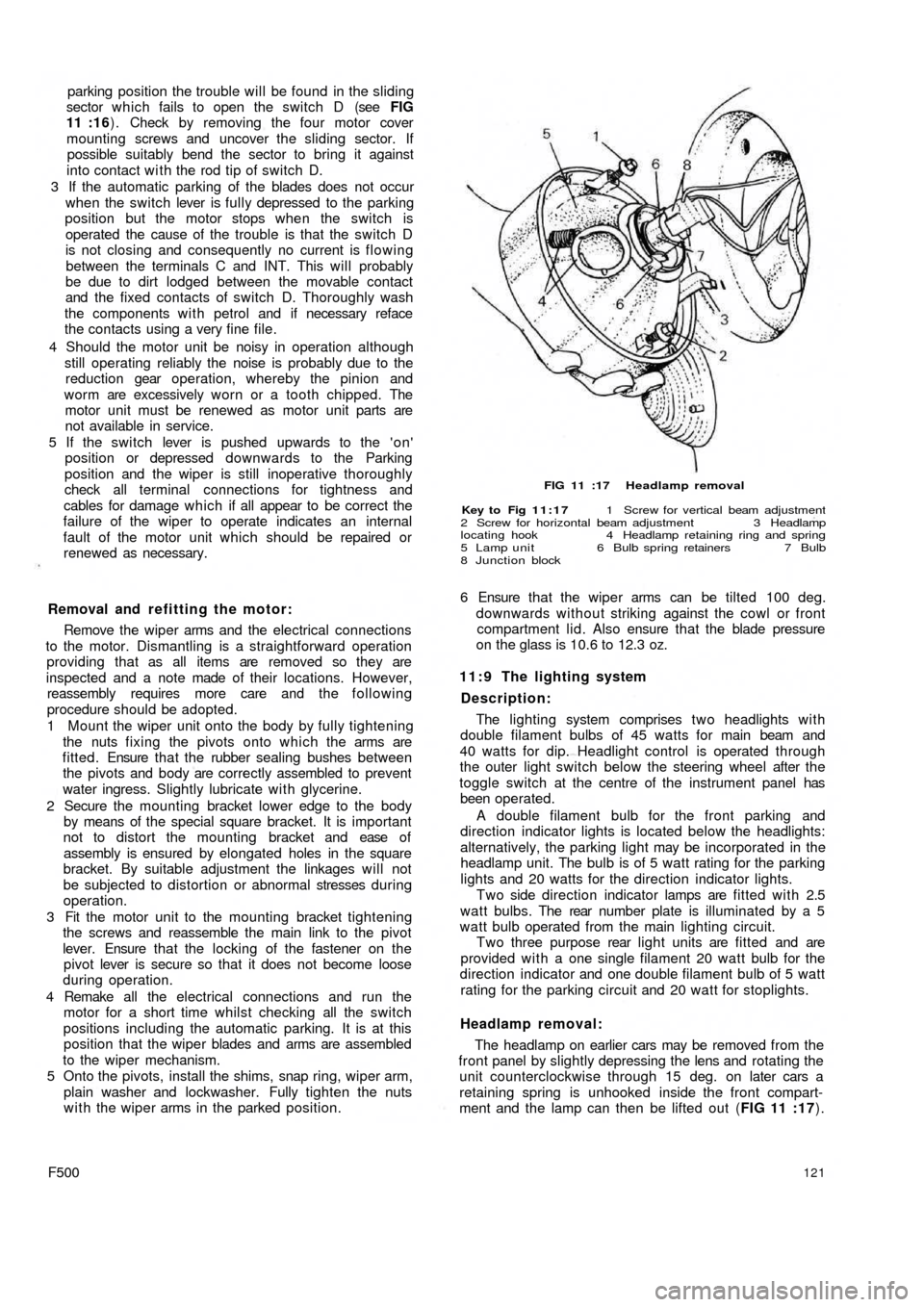
parking position the trouble will be found in the sliding
sector which fails to open the switch D (see FIG
11 :16) . Check by removing the four motor cover
mounting screws and uncover the sliding sector. If
possible suitably bend the sector to bring it against
into contact with the rod tip of switch D.
3 If the automatic parking of the blades does not occur
when the switch lever is fully depressed to the parking
position but the motor stops when the switch is
operated the cause of the trouble is that the switch D
is not closing and consequently no current is flowing
between the terminals C and INT. This will probably
be due to dirt lodged between the movable contact
and the fixed contacts of switch D. Thoroughly wash
the components with petrol and if necessary reface
the contacts using a very fine file.
4 Should the motor unit be noisy in operation although
still operating reliably the noise is probably due to the
reduction gear operation, whereby the pinion and
worm are excessively worn or a tooth chipped. The
motor unit must be renewed as motor unit parts are
not available in service.
5 If the switch lever is pushed upwards to the 'on'
position or depressed downwards to the Parking
position and the wiper is still inoperative thoroughly
check all terminal connections for tightness and
cables for damage which if all appear to be correct the
failure of the wiper to operate indicates an internal
fault of the motor unit which
should be repaired or
renewed as necessary.
Removal and refitting the motor:
Remove the wiper arms and the electrical connections
to the motor. Dismantling is a straightforward operation
providing that as all items are removed so they are
inspected and a note made of their locations. However,
reassembly requires more care and the following
procedure should be adopted.
1 Mount the wiper unit onto the body by fully tightening
the nuts fixing the pivots onto which the arms are
fitted. Ensure t h a t the rubber sealing bushes between
the pivots and body are correctly assembled to prevent
water ingress. Slightly lubricate with glycerine.
2 Secure the mounting bracket lower edge to the body
by means of the special square bracket. It is important
not to distort the mounting bracket and ease of
assembly is ensured by elongated holes in the square
bracket. By suitable adjustment the linkages will not
be subjected to distortion or abnormal stresses during
operation.
3 Fit the motor unit to the mounting bracket tightening
the screws and reassemble the main link to the pivot
lever. Ensure t h a t the l o c k i n g of the fastener on the
pivot lever is secure so that it does not become loose
during operation.
4 Remake all the electrical connections and run the
motor for a short time whilst checking all the switch
positions including the automatic parking. It is at this
position that the wiper blades and arms are assembled
to the wiper mechanism.
5 Onto the pivots, install the shims, snap ring, wiper arm,
plain washer and lockwasher. Fully tighten the nuts
with the wiper arms in the parked position.
F500
FIG 11 :17 Headlamp removal
Key to Fig 11:17 1 Screw for vertical beam adjustment
2 Screw for horizontal beam adjustment 3 Headlamp
locating hook 4 Headlamp retaining ring and spring
5 Lamp unit 6 Bulb spring retainers 7 Bulb
8 Junction block
6 Ensure that the wiper arms can be tilted 100 deg.
downwards without striking against the cowl or front
compartment lid. Also ensure that the blade pressure
on the glass is 10.6 to 12.3 oz.
1 1 : 9 The lighting system
Description:
The lighting system comprises t w o headlights with
double filament bulbs of 45 watts for main beam and
40 watts for dip. Headlight control is operated through
the outer light switch below the steering wheel after the
toggle switch at the centre of the instrument panel has
been operated.
A double filament bulb for the front parking and
direction indicator lights is located below the headlights:
alternatively, the parking light may be incorporated in the
headlamp unit. The bulb is of 5 watt rating for the parking
lights and 20 watts for the direction indicator lights.
Two side direction indicator lamps are fitted with 2.5
w a t t b u l b s . The rear number plate is illuminated by a 5
watt bulb operated from the main lighting circuit.
Two three purpose rear light units are fitted and are
provided with a one single filament 20 watt bulb for the
direction indicator and one double filament bulb of 5 watt
rating for the parking circuit and 20 watt for stoplights.
Headlamp removal:
The headlamp on earlier cars may be removed from the
front panel by slightly depressing the lens and rotating the
unit counterclockwise through 15 deg. on later cars a
retaining spring is unhooked inside the front compart-
ment and the lamp can then be lifted out (FIG 11 :17).
121
Page 115 of 128
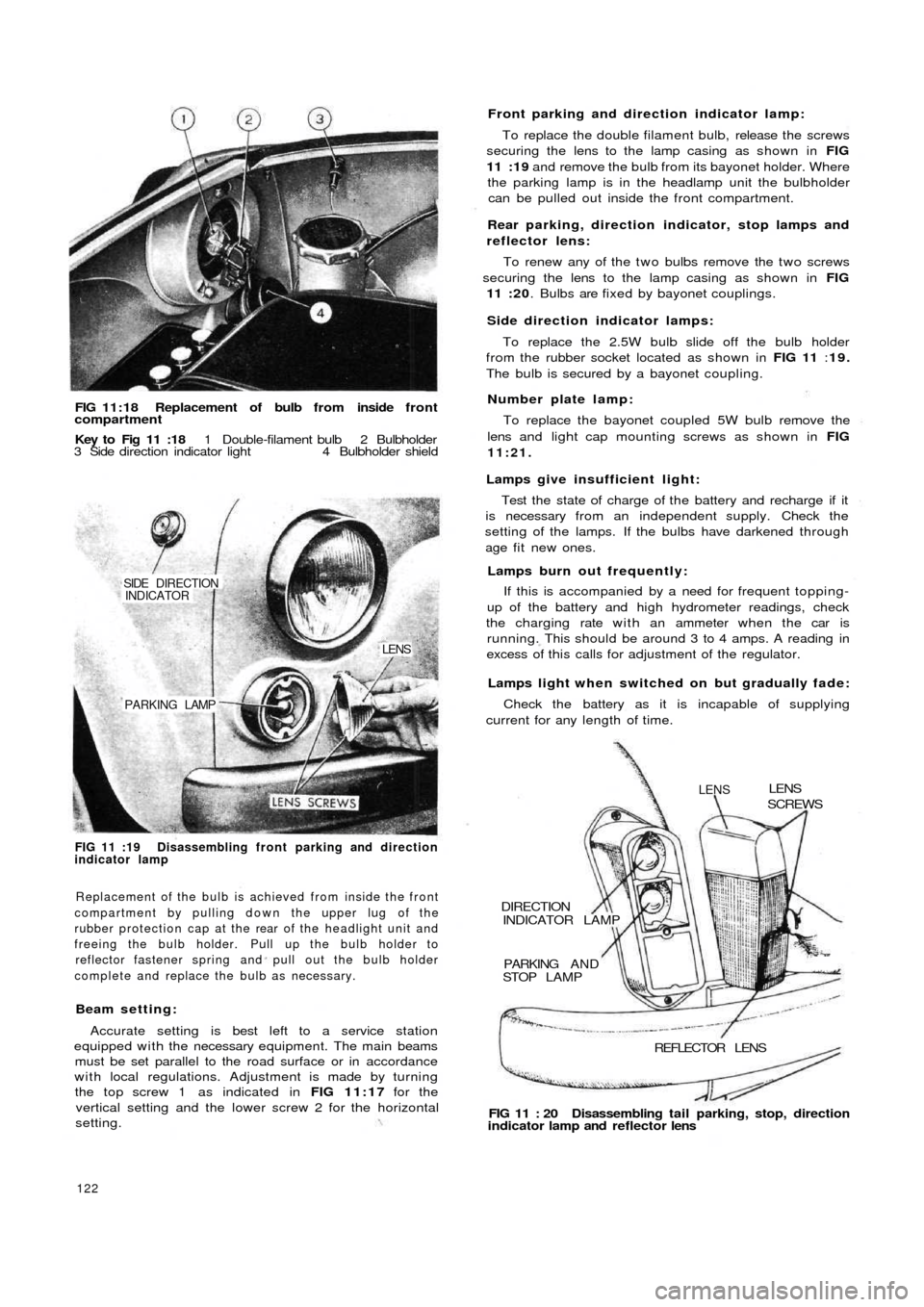
FIG 11:18 Replacement of bulb from inside f r o n tcompartment
Key to Fig 11 :18 1 Double-filament bulb 2 Bulbholder
3 Side direction indicator light 4 Bulbholder shield
PARKING LAMP
LENS
SIDE DIRECTIONINDICATOR
FIG 11 :19 Disassembling front parking and direction
indicator lamp
Replacement of the bulb is achieved from inside the front
compartment by pulling down the upper lug of the
rubber protection cap at the rear of t h e headlight unit and
freeing the bulb holder. Pull up the bulb holder to
reflector fastener spring and pull out the bulb holder
complete and replace the bulb as necessary.
Beam setting:
Accurate setting is best left to a service station
equipped with the necessary equipment. The main beams
must be set parallel to the road surface or in accordance
with local regulations. Adjustment is made by turning
the top screw 1 as indicated in FIG 11:17 for the
vertical setting and the lower screw 2 for the horizontal
setting.
122
FIG 11 : 20 Disassembling tail parking, stop, direction
indicator lamp and reflector lens REFLECTOR LENS PARKING A N D
STOP LAMP INDICATOR LAMP
DIRECTION
LENSLENS
SCREWS
Lamps light when switched on but gradually fade:
Check the battery as it is incapable of supplying
current for any length of time. Front parking and direction indicator lamp:
To replace the double filament bulb, release the screws
securing the lens to the lamp casing as shown in FIG
11 :19 and remove the bulb from its bayonet holder. Where
the parking lamp is in the headlamp unit the bulbholder
can be pulled out inside the front compartment.
Rear parking, direction indicator, stop lamps and
reflector lens:
To renew any of the t w o bulbs remove the t w o screws
securing the lens to the lamp casing as shown in FIG
11 : 2 0. Bulbs are fixed by bayonet couplings.
Side direction indicator lamps:
To replace the 2.5W bulb slide off the bulb holder
from the rubber socket located as shown in FIG 11 :19.
The bulb is secured by a bayonet coupling.
Number plate lamp:
To replace the bayonet coupled 5W bulb remove the
lens and light cap mounting screws as shown in FIG
11:21.
Lamps give insufficient light:
Test the state of charge of the battery and recharge if it
is necessary from an independent supply. Check the
setting of the lamps. If the bulbs have darkened through
age fit new ones.
Lamps burn out frequently:
If this is accompanied by a need for frequent topping-
up of the battery and high hydrometer readings, check
the charging rate with an ammeter when the car is
running. This should be around 3 to 4 amps. A reading in
excess of this calls for adjustment of the regulator.